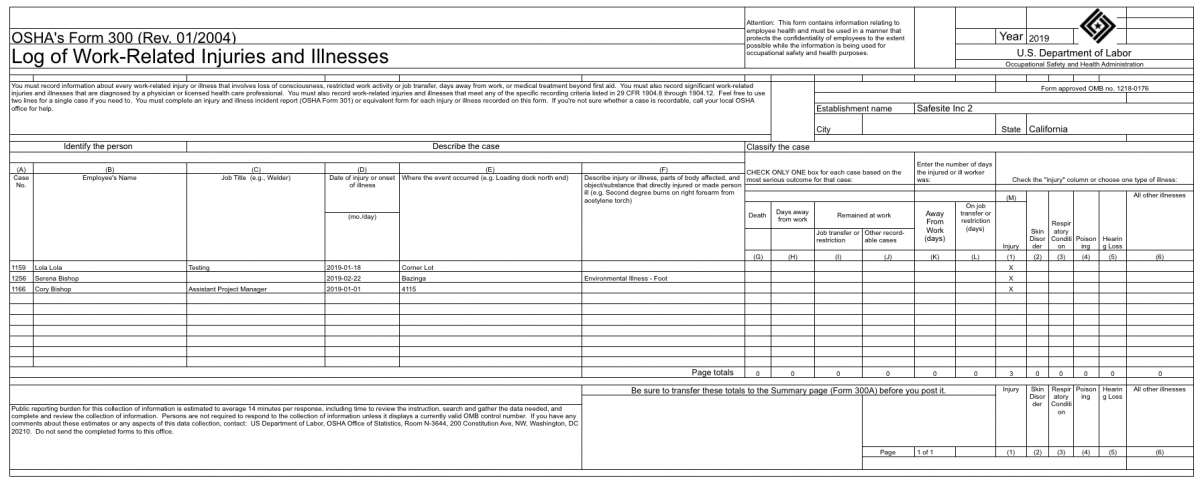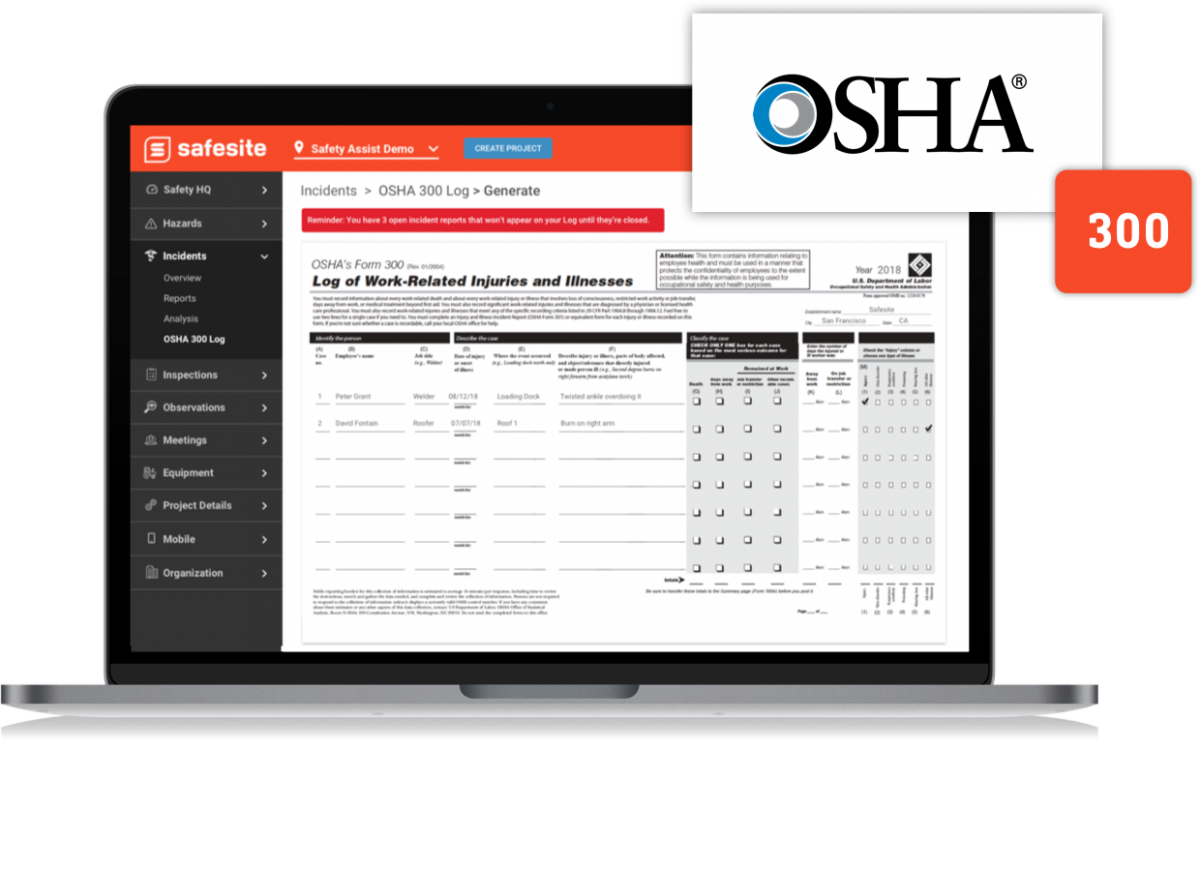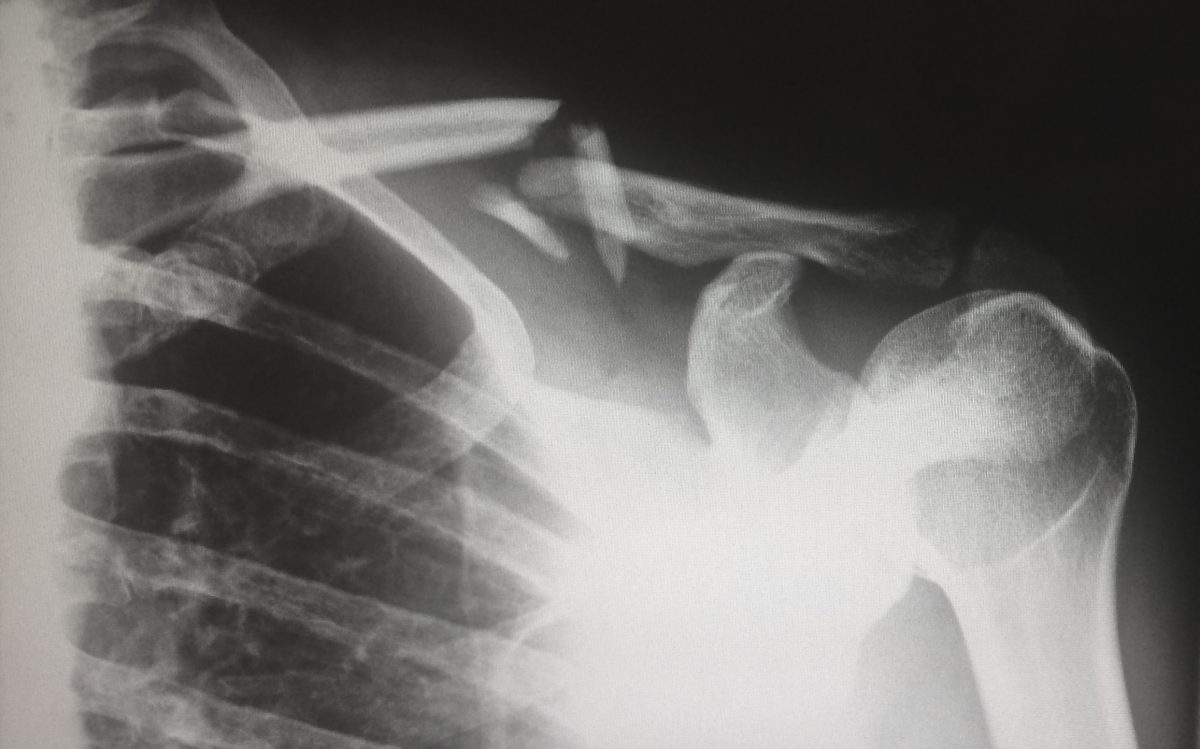Do you know your company’s OSHA recordkeeping obligations?
OSHA requires construction and manufacturing businesses (among others) to complete and regularly update paperwork related to workplace safety.
Perhaps the best known of these is the OSHA 300 log, which records the details of injuries and illnesses that occur at your workplace.
In this article:
Although it seems like just more paperwork, staying up to date and filling out the forms accurately is vital. Failing to complete the paperwork on time and accurately can mean huge fines and hurt your overall compliance program.
OSHA inspectors aren’t shy about doling them out — and these are just the recordkeeping violations and don’t include any workplace safety violations they find. For example, in 2018, OSHA fined one Iowa wind turbine manufacturer $155,000 for violations that included faulty recordkeeping.
What Are the OSHA Injury and Illness Recordkeeping Forms?
Your OSHA recordkeeping requirements include three forms: OSHA 300, OSHA 300a, and OSHA 301.
The OSHA Form 300 is the official log where you document the details of the injuries and illnesses that occur in the workplace. It includes three major sections:
- Identifying the injury/illness (name, case number, job title)
- Describing the injury (date of injury, where it occurred, description of injury/illness)
- Classifying the injury using the checkboxes (result of the injury (e.g., missed work, hospitalization) and general type of injury/illness)

When you record the illness or injury on the 300 log, you also need to fill out Form 301 at the same time. Form 301 is the Injury and Illness Incident Report for each individual event, and it gives you more space to describe the injury or illness as it occurred in context.
The 301 report is where you tell the story of what happened, why, and what the effects were for the employee.
At the end of the year, you need to complete Form 300A, which is your summary report of the log. You use Form 300 to complete Form 300A by identifying:
- Total number of deaths
- Total number of cases with days away from work
- Total number of cases with job transfer or restriction
- Total number of other recordable cases
- Total number of days away from work
- Total number of days of job transfer or restriction
- Total number of injuries, skin disorders, respiratory conditions, posionings, hearing losses, and other illnesses
This form is only a tally of the impacts of injuries and illnesses at your establishment. It doesn’t include any personal information about employees.
What Changes Has OSHA Made to the Requirements?
OSHA introduced the first major recordkeeping change in 2002, when it announced the Forms 300, 300A, and 301. The 2002 updates also included the need to report needlestick/sharps injuries, musculoskeletal disorders, tuberculosis transmission, and standard threshold shift (STS) hearing loss cases.
The next big update came in 2015, when OSHA updated both reporting and recordkeeping requirements.
As of 2015, you need to report work-related fatalities, hospitalizations, and losses of an eye with a set time frame by either calling OSHA’s 1-800 number or calling your closest area office.
OSHA’s big recordkeeping change in 2015 reflected the list of partially exempt industries, which we describe and link to below. It also added to the list of establishments required to keep records, adding building material and supplies dealers, automotive parts, accessories, and tire stores, and commercial and industrial machinery and equipment rental/leasing to the list among others.
Apart from companies in low-risk industries, employers with more than 10 employees must maintain OSHA Form 300, 300A, and 301—and must post Form 300A in the workplace by February 1. Many organizations with more than 20 employees must also submit Form 300A to OSHA by March 2.
In 2016, OSHA published the latest update called the “Improved Tracking of Workplace Injuries and Illnesses,” rule. It didn’t change the core requirements around recordkeeping. The big change was the need to submit all three forms to OSHA annually if you are in a covered industry and have more than 250 employees.
In January 2019, OSHA issued a “final rule” that removed the requirement to submit Form 300 and Form 301 annually. However, all employers with more than 10 employees and who are not in the list of exempt industries still have logging and posting requirements.
- They must maintain Form 300, 300A, and 301 annually.
- They must post Form 300A in the workplace by February 1, and keep it posted through April 30.
In addition, many organizations who more than 20 employees must also submit Form 300A via OSHA’s Injury Tracking Application by March 2.
COVID-19 OSHA Recordkeeping Requirements
COVID-19 presents several unique challenges for organizations who must comply with OSHA standards. OSHA updates its requirements for COVID-19 regularly, so it’s good to check in on a regular basis to ensure your OSHA 300 log contains everything it needs to.
As of November 2020, OSHA requires organizations to record all COVID-19 cases when a case is work-related and the case meets recording criteria in 29 CFR 1904.7. This means that COVID-19 differs from the flu: you have no obligation to record flu cases, even if they spread through the workplace.
In other words, you won’t record every COVID-19 case that appears in your workplace. But you must investigate each case for work-relatedness and record it on the OSHA 300 log when evidence of work-relatedness appears. OSHA will judge you based on the reasonableness of your investigation and the evidence available to you. And because most confirmed COVID-19 cases will result in days away from work, the vast majority of work-related cases should be on your OSHA 300 log.
Find the memorandum on enforcement guidance for COVID-19 records here and OSHA’s dedicated COVID-19 page here.
Why Does OSHA Have Strict Recordkeeping Requirements?
OSHA recordkeeping requirements aren’t there to rub workplace injuries in your face or shame you.
The point of these strict requirements is to track illnesses and injuries so that you can prevent them in the future. Recording these helps you (and OSHA) identify patterns and correct dangerous or hazardous conditions.
These will also help you find sticking points both before other employees get hurt or before your OSHA inspector finds them for you and fines you for them.
Who Needs to Comply with OSHA Recordkeeping Requirements?
Almost every employer with over ten employees needs to complete an OSHA Form 300.
The only exception is if your business falls into a listed industry defined by the 2015 rule update.
The 2015 update listed certain industries that OSHA deems to be “low-risk,” and these are only partially-exempt.
As of 2015, some of these partially-exempt industries include:
- Management, scientific, and technical consulting services
- Accounting, tax preparation, bookkeeping, and payroll services
- Building, professional, labor, political, and similar organizations
- Investigation and security services
- Travel arrangement and reservation services
- Pipeline transportation of crude oil
- Pipeline transportation of natural gas
- Other pipeline transportation
- Jewelry, luggage, and leather goods stores
- Clothing stores
- Shoe stores
- Junior colleges
- Dentist offices
- Physician offices
- Outpatient care centers
- Personal care services
- Deathcare services
- Religious organizations
- Social advocacy organizations
- Civil and social organizations
- Legal services
- Insurance carriers
- See all partially exempt industries
If your business is on the list above or the complete list (linked below), then you don’t need to meet OSHA recordkeeping requirements unless OSHA specifically asks you to do so in writing. OSHA’s ability to require you to adhere to recordkeeping rules anyway is why you are only “partially” exempt.
You can find a link to the full list of partially exempt industries (as of January 1, 2015) on the “Non-Mandatory Appendix to Subpart B” page.
Where and When Do You Post Your Logs?
If OSHA requires you to complete OSHA Form 300 logs, then you need to make sure they are up-to-date at all times. You shouldn’t be filling them out monthly, quarterly, or worse—at the end of the year.
You also need to post a summary of the forms from the previous year from February through April of the following year. For example, you’ll post your 2021 summary between February and April 2022.
Although you only need to keep them up for a few months, you need to keep all records at the worksite for at least five years.
What is the OSHA Final Rule?
Previously, OSHA required organizations with 250 or more employees to file their Form 300 and 301 electronically. However, you no longer need to do this. In what’s called the “OSHA Final Rule,” the administration took back the requirement for electronic filing.
OSHA rescinded the electronic filing rule to protect workers’ privacy because Form 301 contains personal information about your employees, including their name, date of birth, and information about their medical care.
However, only the electronic filing aspect of the law disappeared. Nothing reverses your need to keep, post, and maintain your 300, 301, or 300A for OSHA inspection. In addition, these organizations do need to electronically file Form 300A annually via OSHA’s Injury Tracking Application.
Using Digital Records to Fulfill OSHA Requirements
Just because OSHA no longer forces you to use electronic filing for Form 300 and Form 301 doesn’t mean you should revert back to paper or a spreadsheet. In addition, your Form 300 recordkeeping affects your efficient and accurate completion and reporting of Form 300A annually. You can use a digital safety management system, like Safesite, to log events in real-time and synchronize your data so that your entire team can see it.

Digital recordkeeping is the preferred way to ensure your forms are correct, up-to-date, and easy to access. With Safesite’s real-time incident reporting and digital OSHA 300 log, you can log recordable incidents immediately. You can also schedule follow-up compliance actions to ensure you take steps to protect your employees.
OSHA overturned the mandatory electronic rule to protect employees in private companies from being identified through Freedom of Information Act (FOIA) requests. However, FOIA requests only apply to the federal government: they don’t apply to your business. So there’s no reason for you to skip digital services as long as you secure your data.
What Do You Report or Record for OSHA and When?
If an injury is severe and requires hospitalization within 24 hours of the work-related incident, then you need to report it to OSHA directly within 24 hours after making the determination. In the case of COVID-19, you need to report hospitalizations of work-related COVID-19 cases when the hospitalization occurs within 24 hours of exposure to the virus.
OSHA needs to know about any fatalities at work that occur within 30 days of the incident within 8 hours after the death. When dealing with COVID-19 fatalities, the same rules apply: if a worker dies within 30 days of workplace exposure to the virus, then new guidance from October 2020 says you must report their death to OSHA.
Learn more about how to report severe injuries and fatalities here.
All recordable injuries or illnesses need to go on the Form 300 Log, including those reported directly to OSHA.
How Do You Know if a Case is Recordable?
Not every injury or illness needs to go on the OSHA 300 log.
Generally, you only need to record an injury or illness if it involves:
- Fatality
- Occupational hearing loss
- Loss of consciousness
- Days off work
- Restricted work, transfer
- Medical treatment
In other words, if an injury requires an employee to receive medical treatment beyond first aid or go on restricted and/or modified duty, then it goes on the OSHA 300 log.
You don’t need to record cases requiring only first aid (or that don’t include elements from the list above).
What counts as first aid? OSHA defines first aid as “medical attention that is usually administered immediately after the injury occurs and at the location where it occurred. It often consists of a one-time, short-term treatment and requires little technology or training to administer.”
Minor wounds like cuts, scrapes, scratches, and minor burns usually fall under first aid, even if you needed a bandage or disinfectant. Here’s an example: If an employee cuts their thumb and needs treatment at work, it’s not reportable. If they cut their thumb and need stitches at the ER, it goes on the log.

Recorded injuries and illnesses also need to be work-related. OSHA’s definition of “work relationship” is very broad.
Standard Number 1904.5 definition of “work-relatedness” says: “You must consider an injury or illness to be work-related if an event or exposure in the work environment either caused or contributed to the resulting condition or significantly aggravated a pre-existing injury or illness.”
Understanding what does and doesn’t count as work-related is important because it means that if your employee has a pre-existing injury, and one of your processes doesn’t respect it, then it could still go on your record if it is a “recordable injury.” For example, if you hired an employee who already had a hernia, and your work conditions aggravated it, then you have to record the hernia even if it didn’t originate on your worksite.
There are a few exceptions listed in 1904.5(b). You don’t need to record the injury under these circumstances:
- If the employee was at work as a member of the public and not on the clock at the time of the injury
- If the injury or illness involves symptoms that appear at work but are the result of something entirely non-work related
- If the injury happened thanks to the employee’s voluntary participation in a wellness program (like fitness exam, recreation activity, or a flu shot)
- If the illness is the result of the employee eating or drinking something they brought in or ordered
- If the injury occurs when the employee is completing personal tasks during work hours (at the establishment
- If the injury is self-inflicted (intentionally)
- If the illness is the common cold or influenza
- If the illness is mental illness (unless a licensed health care professional deems otherwise, e.g., PTSD derived from work)
- If the injury occurs on the access road or in the parking lot during the employee’s commute
What Are the Most Common OSHA Recordkeeping Mistakes?
OSHA’s recordkeeping forms are fairly straightforward, but some companies still make mistakes in an attempt to make sure their forms are complete or because they received bad information.
One of the most common mistakes is recording every incident in an attempt to avoid a fine. You don’t need to record every cough, sneeze, or cut, nor should you. Adding too many non-recordable injuries to the log can raise your incidence rate, which can lead to more OSHA inspections and even cause your insurance rates to grow. You may even struggle to land contracts if it looks like you have a poor safety record.
If you worry about recording an incident and decide against it, you can document your decision in good faith in case it comes up later.
A second common mistake is leaving temp employee injuries off the register. Construction and manufacturing companies rely on temps who are expressly not full-time employees. OSHA says that if they work for you — in any capacity, including “day-to-day supervision” — then a recordable injury needs to go on your 300 log.
Third, you need to keep logs for all your individual establishments. That means if you have three sites running at once, you need three logs — one dedicated to each site.
What Are the Penalties for Failing to Maintain an OSHA 300 Log?
OSHA violations increased again in January 2022.
Recordkeeping violations can run up to $14,502. Yes, that means not posting your Form 300A (report of your log) at your establishment can cost you $14,502 if, during an OSHA inspection, you are found to be in violation of the requirements.
Are You Meeting Your OSHA Recordkeeping Obligations?
Your OSHA recordkeeping obligations not only keep your business compliant with federal regulations but also keep your employees safe from preventable injuries and illnesses.
The OSHA 300, 300a, and 301 provide a full list of the recordable injuries and illnesses that occur at your covered workplace. If you aren’t on the partially-exempt list of industries, then completing these forms in a timely manner is essential. And you shouldn’t forget to report hospitalizations and deaths directly to OSHA.
Maintain a Digital OSHA Log
Digital recordkeeping helps limit your paperwork while ensuring all your recordkeeping obligations are met.
Safesite is a robust safety management system that makes meeting your recordkeeping obligations simple. Sync your recordable injuries with your OSHA 300 Log. Download it, print it, and use it to prepare Form 300A for display from February 1 through April 30 each year.
